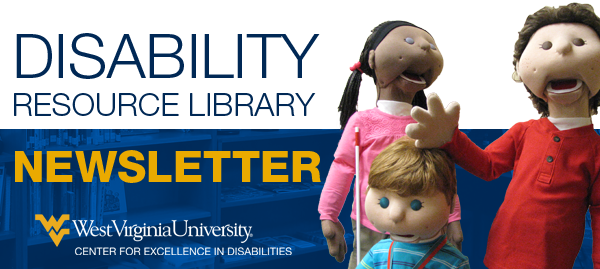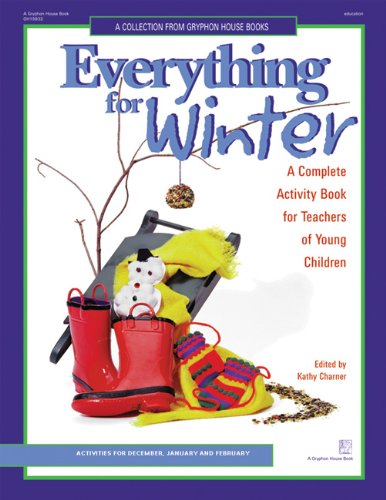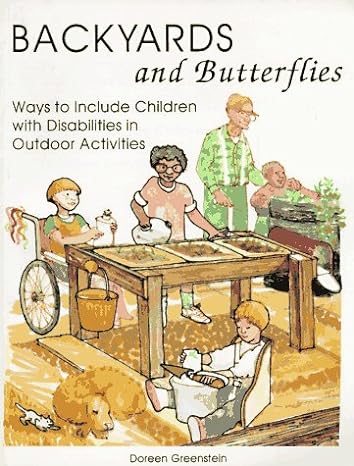
Winter Fun

Winter can be a magical time full of beautiful snowfall and sparkling icicles. It can also bring harsh weather that makes it difficult to plan fun activities and events with friends and families. This issue of the Disability Resource Library Newsletter will highlight fun, accessible indoor and outdoor activities for children with disabilities, regardless of the weather. We will discuss easy accommodations and modifications for those with different abilities, ideas for inclusive winter activities, and West Virginia recreation resources. Be sure to check out the books, games and adaptive toys available from the West Virginia Assistive Technology System (WVATS) and the Disability Resource Library (DRL) for winter fun as well. We hope you enjoy your Winter Fun!
Featured Resources
All featured resources are available to borrow from the DRL
Browse more resources.Everything for Winter - curriculum
Re-energize winter classrooms and your home with these fun-filled activities for December, January and February. Includes music and movement, science activities, art activities, snack and cooking activities.
Backyards and Butterflies: Ways to Include Children with Disabilities in Outdoor Activities - book

Author: Doreen Greenstein (1999)
This is a colorful illustrated book that shows parents and anyone who works with children with special needs how to design and build simple, inexpensive assistive technology devices that open the world of outdoor experiences to children. Most ideas thought up by parents.
Featured Technology
To browse more technologies, click here.Button/Zip Hook Combo

Great for help with dressing all year long. This small device assists in button and zip fastening. It incorporates a stainless-steel shaped hook at one end and a "C" hook at the other. A button hook on one end enables buttons to be easily pulled through the hole. At the other end is a zip puller, ideal for people who lack fine motor coordination or have use of only one hand.
Inclusive Activities
Whether you are heading out into that snowy winter wonderland (be sure to bundle up) or staying warm indoors, there are plenty of fun activities for everyone to try this winter.
Outdoor Activities:
Getting outside is a wonderful way to spend a winter day, especially when there’s snow on the ground! It is a great way to get some fresh air and exercise. Check out these accessible outdoor winter activities:
- Make snowballs: Making snowballs can be fun, but snowball fights can be too intense for some children. Consider making snowballs to throw at various objects outdoors, such as trees, rocks or walls. Your child will still get a fun winter sensory experience without being as stressed. This method also requires less movement for children who might have physical challenges.
- Paint the snow: A creative and fun alternative to playing in the snow is to paint it! Simply fill squirt bottles with water and food coloring (make sure you use a lot of coloring), then turn the snow into your own personal artwork.
- Go sledding: Sledding is a great activity for kids because it gets them moving and interacting with friends and family. If your child has a physical disability, try using a sled with a rope attached so you can pull them through the snow. You could also invest in an adaptive sled designed for people with disabilities. Some local sledding spots can draw crowds on snow days. If you prefer to stay closer to home, try creating your own “hills” by piling up snow in your yard. You can make them big or small based on each child’s ability levels. Don’t forget safety! It’s important that your child wears a helmet while sledding to avoid injuring their head. Finally, be sure to always watch your children, sit in the sled with them if they are younger, and advise them to clear the sledding area once their sled comes to a stop to avoid collisions with others.
Indoor Activities:
You don’t need to spend hours outside in the snow to make the most of your winter day. Kids with disabilities may prefer staying indoors due to physical or sensory obstacles such as aversion to coldness or too many clothing layers. If your child doesn’t want to go out into the snow, or if you don’t feel like dealing with snow-soaked clothes, there are plenty of fun, creative and inclusive activities kids can do indoors.
- Build a snowman: Everyone wants to build a snowman! A simple 2:1 combination of corn starch and shaving cream will yield a magical mixture of shapeable, snow-like material. Your child can mold the mix into balls to create a snowman, then outfit it however they see fit. This activity gives children a sensory experience using their hands without the hassle of going outside.
- Get snowed in inside your fort: Who doesn’t remember building a fort in their living room as a child? Your family can construct their own fort using pillows, blankets and other items around the house. Once the kids are inside, drop cotton balls or mini marshmallows outside the fort’s “windows” to make it feel like it’s snowing. Make some hot cocoa or a snack to enjoy inside your own little fort.
- Bake snowflakes: You don’t have to go outside to catch some snowflakes. Make your own from the comfort of your kitchen and indulge your child’s fun, crafty side. Warm up some flour tortillas in the microwave, fold them into fourths and then cut out patterns to make snowflakes the same way you would with paper. To make your snowflakes tastier, brush them lightly with melted butter, sprinkle them with cinnamon sugar and bake them for a few minutes until they crisp up. You can even add blue sugar sprinkles to resemble icy snow.
- Dance: This is a fun activity for all children, and can be done seated as well. You can even fit in some stretching while dancing.
Recreation In West Virginia
- Challenged Athletes of West Virginia:
Check out the adaptive skiing program at Snowshoe Mountain Resort. Ages 4+. - Adaptive Dance Classes at Oglebay Institute:
Classes include adaptive cheer, dance, wheelchair specific, mixed abilities, low vision and more. - Special Olympics of West Virginia:
Provides year-round sports training and competition for children and adults with disabilities. - Full Accessible Recreation in West Virginia Guide:
Includes locations in each county where children and adults of all abilities can enjoy accessible recreation. - Oglebay Festival of Lights:
Drive-through light show happening November 9,2023 - January 8, 2024- Donations suggested.
Child’s Champion:
Kimberly Bonnet, MA Reading Specialist

Kimberly is a Title I Teacher at Leading Creek Elementary in Lewis and Gilmer counties. Her focus is to reach as many students as possible. She is a member of the West Virginia Education Association (WVEA) where she served on the Executive Committee and was elected by state delegates to serve on the National Education Association (NEA) Board of Directors. Serving in this capacity, she was able to advocate for issues faced by our rural schools in West Virginia. She also helped lobby Congress to advocate for public education and child nutrition. Kimberly has received specialized training in both leadership and social justice.
She serves on her schools Leadership Team and is the Faculty Senate Chair. In addition to her Title I position, Kimberly is also the Title I Facilitator and Parent Involvement Coordinator for her school. She loves coordinating activities like Bingo for Books, Family Game Night and Adopt-a-Pet to help families support their child’s education at home.
Families play seasonal-themed, traditional and sight-word bingo for a chance to win books and door prizes during the Bingo for Books event. Family Game Night is also a big hit at Leading Creek. Families rotate through different classroom stations like a math room with dominos, dice and card games, a board game room and a room of STEM challenges like building a catapult or making bridges using toothpicks and marshmallows. Adopt-a-Pet allows children to choose a stuffed animal to be their reading buddy and is popular among first-grade students.
Kimberly also sponsors an annual Literature Fair where students create a display board and give an oral report about a book of their choosing. The winners get to attend the regional Literature Fair at Glenville State University, and the winner from that regional fair gets to present in the state reading conference at the Greenbrier Resort.
Kimberly hopes to continue working with the youth of rural West Virginia as a teacher. She attends conferences and continues her education as much as possible. She said, “I believe we all need to be life-long learners.” She also says that while being a teacher is a hard job, she feels blessed beyond measure with every successful learning journey. Seeing a lightbulb come on and a student say, “Mrs. Bonnet, I can read!” is her greatest reward!
